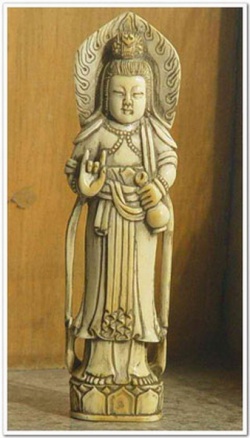Nirvana.
nirvana
涅槃 (Skt; Pali nibbana; Jpn nehan )
Enlightenment, the ultimate goal of Buddhist practice. The Sanskrit word nirvana means "blown out" and is variously translated as extinction, emancipation, cessation, quiescence, or non-rebirth. Nirvana was originally regarded as the state in which all illusions and desires as well as the cycle of birth and death are extinguished. Hinayanists distinguish two types of nirvana.
The first is that of the arhat who has eliminated all illusions and will no longer be reborn in the six paths, but who is still bound to the world of suffering in that he possesses a body. This is called the nirvana of remainder or incomplete nirvana.
The second is that which the arhat achieves at death, when both body and mind—the sources of suffering—are extinguished. This is called the nirvana of no remainder or complete nirvana. Because Hinayana Buddhism teaches that the ultimate goal of practice can only be achieved at death, it was called the teaching of "reducing the body to ashes and annihilating consciousness." Mahayanists criticized the practice directed toward this goal as escapist and indifferent to the salvation of others, and probably derogatively coined the above phrase. In Mahayana Buddhism, nirvana came to mean not so much an exit from the phenomenal world as an awakening to the true nature of phenomena, or the attainment of Buddha wisdom. Even in Mahayana sutras, however, this attainment is regarded as requiring the elimination of earthly desires in the same manner as expounded in the Hinayana teachings. Therefore, it is taught that nirvana requires an immeasurably long period to achieve.
In contrast, the Lotus Sutra teaches that, by awakening to one's innate Buddha nature, one can reach the state of nirvana in his or her present form as an ordinary person who possesses earthly desires and undergoes the sufferings of birth and death. It reveals the principle that the sufferings of birth and death are none other than nirvana. From the standpoint of the Lotus Sutra, birth and death are two integral phases of eternal life. Nirvana, therefore, is not the cessation of birth and death, but a state of enlightenment experienced as one repeats the cycle of birth and death.The sufferings of birth and death and nirvana, or enlightenment, are inseparable: it is not necessary to extinguish one in order to attain the other. These sufferings belong to the nine worlds, and nirvana, to the world of Buddhahood. The nine worlds and the world of Buddhahood are mutually inclusive. By manifesting the state of Buddhahood, one enjoys nirvana while repeating the cycle of birth and death.
